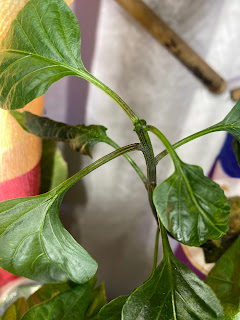This will not, for the time being, be as picture-heavy as I would prefer; like an idiot, I didn't take good pictures of my plants last round, so I won't be able to include good pictures of the full cycle until my next set of sprouts mature sufficiently. However, I've had enough requests for assistance with pepper pruning, that it's worthwhile going ahead and writing the post even with insufficient pictures.
 |
| Confetti Bell Pepper in AGFarm24XL, loaded with peppers! |
So, on to the pruning! As with all pruning, it is best done with a sharp set of shears or scissors, that has been sterilized, such as with rubbing alcohol. My personal preference is a pair of embroidery scissors; they are very sharp, and come to a very fine point, enabling you to get in very tight spaces easily. I use them only for pruning, so they don't get dulled or nicked from other uses. I'd be lying, though, if I said I didn't just as often use my fingernails - but sterilization is still important!
When to Prune Pepper Plants
You will find some different information on this point looking around the web. The important thing to keep in mind, is that we are trimming to maximize horizontal growth, since we are growing in height-limited hydroponics units. This means the 'when' - and the 'how' - are a little different that outdoor garden growers, which is what the majority of information available is geared for. Most of that information will result in slender, tall plants – the exact opposite of what we are after.
When going for short, bushy pepper plants, the optimal time to begin pruning is as soon as you notice the main stem split in half (or thirds) at the top, forming a Y. Ideally, it should be while it's still basically just buds, so as not to have put as much energy into growing the new leaves, but any time after it splits is fine. This can be just about heartbreaking the first time you do this, because those splits are also where flower buds form, meaning you will be removing its first buds. But I promise, it really is worth it. You will end up with so many more buds afterwards because of the pruning.
As soon as you see the split, cut directly underneath it. If possible, cut above any leaf nodes beneath the split.
 |
| Y visible at top - see the two sets of new leaves, and the first flower bud. |
 |
| Y and flower bud removed. Note that I removed the two stems where they met, but left the node and leaves directly below intact. |
Note the bud in the join of the Y in the first picture. Painful as it is, you need to remove that first flower bud. You don't want the plant focusing on growing flower/fruit while you're still trying to shape the plant.
Another one, before and after the Y trim:
You will then also want to remove some of the mature leaves. How many you remove will depend on whether you have side growth already formed or not. If not, you want to take about half of them. Focus more on upper leaves than lower ones; the point is to allow light to get to the buds to stimulate growth and then to provide nutrients to the plant once the new leaves start growing Do not break off the leaf stems, as you may damage the buds at their base. Cut the actual leaf stem, as seen here (same plant as above):
 |
| Same plant as above, with about half the leaves removed to allow light to reach the stem (and soon-to-be side branches.) |
Once the side branches have begun to grow and put out leaves, remove the remainder of the mature leaves you left.
Personally, I repeat this process, cutting off at the split, on all the secondary side branches (off the main trunk), then again for about half the tertiary branches (off the secondaries). This results in a very compact, but very prolific plant.
This series of pictures is beginning to flowering on a small habanada plant. This little guy is not exactly typical, because it grew in miniature for some reason (at the beginning, it's only about 2" tall(!), and by the end still only about 3-4") and also had a lot of side growth by the time the main trunk split. Because it was so tiny (I nicknamed it 'Sir Shrimpy', hah), I didn't trim the secondary splits, as I didn't think it could support much more fruit. Still, it gives you an idea of the process and results.















No comments:
Post a Comment